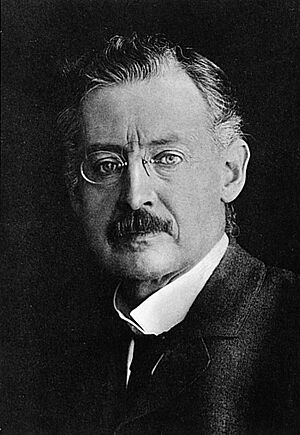Carl Runge facts for kids
Quick facts for kids
Carl Runge
|
|
|---|---|

Carl David Tolmé Runge
|
|
| Born | 30 August 1856 |
| Died | 3 January 1927 (aged 70) |
| Citizenship | German |
| Alma mater | Berlin University |
| Known for | Runge–Kutta method Runge's phenomenon Runge's theorem Laplace–Runge–Lenz vector Schumann–Runge bands |
| Scientific career | |
| Fields | Mathematics Physics |
| Institutions | Leibniz University Hannover (1886–1904) University of Göttingen (1904–1925) |
| Doctoral advisor | Karl Weierstrass Ernst Kummer |
| Doctoral students | Max Born Friedrich Adolf Willers Hermann König |
Carl David Tolmé Runge (born August 30, 1856 – died January 3, 1927) was a German mathematician, physicist, and spectroscopist. He helped create the Runge–Kutta method, which is a very important tool in numerical analysis. This method helps solve math problems by using step-by-step calculations.
Life and Discoveries
Carl Runge spent his early childhood in Havana, Cuba. His father worked there as a consul for Denmark. Later, his family moved to Bremen, Germany. Sadly, his father passed away when Carl was young.
In 1880, Carl earned his Ph.D. in mathematics from Berlin University. He studied under famous mathematicians like Karl Weierstrass. After his studies, he became a professor in Hanover, Germany, in 1886.
Carl was interested in many different areas of science. These included mathematics, spectroscopy (studying light and how it interacts with matter), geodesy (measuring the Earth), and astrophysics (studying stars and space).
He didn't just do pure math. He also did experiments, especially with spectral lines. These lines are like unique fingerprints that different elements leave in light. He worked with Heinrich Kayser on this. Carl was very keen on using this work to understand stars and other objects in space through astronomical spectroscopy.
In 1904, Carl moved to the University of Göttingen. He stayed there until he retired in 1925.
His Family of Scientists
Carl Runge's family also had many talented people. His daughter, Iris, became a mathematician, just like him. His son, Wilhelm, was a pioneer in developing radar technology. Another daughter, Nerina, married the well-known mathematician Richard Courant. It seems scientific talent ran in the family!
Honors and Legacy
Carl Runge's work was so important that he has been honored in several ways:
- The crater Runge on the Moon is named after him.
- The Schumann–Runge bands of molecular oxygen are named after him and Victor Schumann. These bands are specific patterns seen when oxygen molecules absorb light.
See also
 In Spanish: Carl Runge para niños
In Spanish: Carl Runge para niños
- Runge's law
- Runge's method for Diophantine equations.

